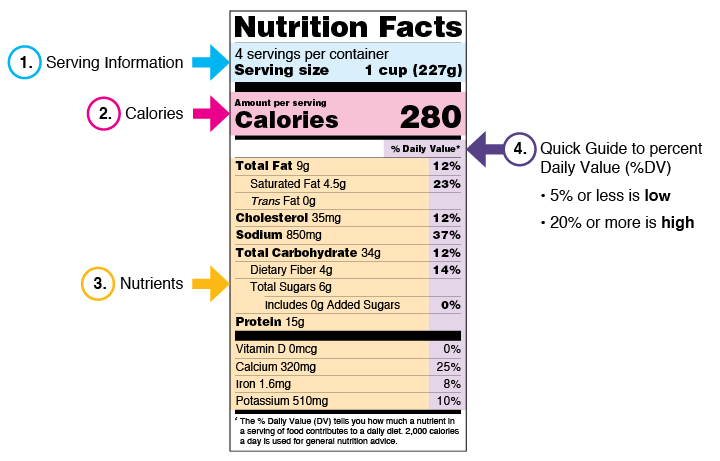Whenever you go into a supermarket, it can feel like a bit of a mission to navigate the shop’s layout, confusing pricing, and offers, all while trying to find a meal that is not only nutritious but won’t leave a hole in your wallet.
If you are learning how to cook, reading food labels is extremely important to ensure you buy the right ingredients.
Although the standards don’t cover every type of food sold in India (for example, foods that are sold loose are subject to different labeling standards) knowing how to understand food labels, particularly in supermarkets, can prove useful if you’re looking to purchase better quality food.

Important Food Labels In India
The Food Labelling Act in India refers to the Food Safety and Standards (Packaging and Labelling) Regulations, 2011. These regulations provide guidelines for the labelling and packaging of food products in India.
FSSAI Logo
The Food Safety and Standards Authority of India (FSSAI) logo signifies that the product complies with the standards set by the authority for safety and quality.
The Food Safety and Standards Authority of India (FSSAI) logo is a symbol that is used to identify food products that have been certified by the FSSAI. It is a distinctive mark that signifies that a food product has been certified and meets the safety and quality standards set by the FSSAI.
The purpose of the FSSAI logo is to ensure that consumers can easily identify safe and quality food products in the market. It helps in building trust and confidence among consumers by indicating that the product has undergone necessary testing and complies with the regulations set by the FSSAI. The logo also helps in preventing the sale of adulterated or substandard food products, thereby protecting the health and well-being of consumers.
Vegetarian/Non-Vegetarian 🟢/🔴
Food products are often labeled as vegetarian or non-vegetarian, particularly significant for individuals following specific dietary preferences or restrictions.
The FSSAI requires packaged food products to display a green dot in a square for vegetarian food and a brown dot in a square for non-vegetarian food. This labeling helps consumers easily identify the food type.
For vegetarian food 🟢 : A green dot inside a square on the packaging.
For non-vegetarian food 🔴 : A red dot inside a square on the packaging.
Nutritional Information
This includes details about calories, fat, carbohydrates, protein, vitamins, and minerals per serving size, helping consumers make informed choices about their diet.
The Food Safety and Standards Authority of India (FSSAI) has outlined specific guidelines for the nutritional labelling of food products in India. Here's an overview:
- Mandatory Nutritional Information: FSSAI mandates certain nutritional information that must be displayed on packaged food labels. This includes energy information (in kilocalories), protein, carbohydrates, fats, trans-fat, saturated fat, sugar, and salt content per 100 grams or 100 milliliters of the product.
- Format and Presentation: The nutritional information should be presented in a specific format, typically a table, which includes the specified parameters mentioned above. It should be displayed clearly and prominently on the packaging, making it easy for consumers to read and understand.
- Per Serving Information: Additionally, if the package is likely to be consumed in a single sitting or portion, the nutritional information per serving should also be provided along with the number of servings in the package.
- Percentage of Recommended Dietary Allowance (RDA): FSSAI also recommends including information on the percentage of the recommended dietary allowance for these nutrients per serving.
- Additional Information: Alongside the mandatory nutritional information, manufacturers might include other voluntary nutritional details, such as vitamins, minerals, dietary fiber, etc.
Allergen Information
Labels indicate if the product contains common allergens like nuts, dairy, soy, gluten, etc., crucial for individuals with food allergies or intolerances.
FSSAI mandates that food businesses must declare the presence of common allergens in pre-packaged foods. The allergens that need to be declared include:
- Cereals containing gluten
- Crustacean shellfish
- Eggs
- Fish
- Peanuts
- Soybeans
- Milk and milk products
- Tree nuts
- Sesame seeds
- Sulphites
- Mustard
- Lupin
- Molluscs
These allergens need to be mentioned on the label, either in the list of ingredients or in a separate statement close to the list of ingredients. The declaration must be clear and easily understood by consumers.
Work with a nutritionist in Bangalore or your city, or online, to develop a meal plan that takes your allergies and needs into account.
Date Markings
Labels display "Best Before" and "Use By" dates, guiding consumers on the product's shelf life and consumption timeframe.
The Food Safety and Standards Authority of India (FSSAI) provides guidelines for date markings on food products to ensure their safety and quality. These guidelines typically include:
- Best Before Date: Indicates the date until which the food product is expected to remain in optimal quality if stored properly. It's usually applicable to non-perishable items.
- Use By Date: Specify the last date by which the product should be consumed for safety reasons. It's more common on perishable items like dairy, meats, and ready-to-eat foods.
- Date of Manufacture/Packaging: Indicates when the product was produced or packaged. It helps in tracking the shelf life and ensuring freshness.
- Storage Conditions: Instructions on how the product should be stored to maintain its quality and safety until the specified date.
FSSAI mandates that food products must have clear and visible date markings as per these guidelines to inform consumers about the product's shelf life and safety. Manufacturers must comply with these regulations to ensure consumer health and safety.
Organic Certification
Some products may carry labels indicating they are organic, meeting specific standards for organic production methods.
FSSAI has initiated a program named 'Jaivik Bharat' to guarantee the authenticity of food products labeled and marketed as 'organic' for individuals who prefer consuming authentic organic food.
Country of Origin
Consumers need to know where the food product comes from, as some might prefer locally sourced items or want to be aware of the product's origin for various reasons.
How To Interpret A Food Nutrition Label Right?

Serving Size
In India, nutrition labels typically display serving sizes in grams or milliliters for solid and liquid foods, respectively. The serving size is standardized to provide information on the amount of nutrients present in a single serving of the food product.
It's crucial to check this information as it helps in understanding the nutritional content and making informed dietary choices. Manufacturers in India usually follow guidelines set by the Food Safety and Standards Authority of India (FSSAI) for labeling, which includes serving size information.
Calories
The term "calories" used on these labels refers to kilocalories, which is the standard unit of measurement for energy in food. For instance, when you see "Calories" mentioned as 100 on a food label, it means 100 kilocalories.
Food packaging in India usually follows the guidelines set by the Food Safety and Standards Authority of India (FSSAI), which mandates the inclusion of nutritional information like calories, total fat, saturated fat, carbohydrates, sugars, protein, and sometimes more, depending on the product.
Always remember to check the serving size mentioned on the label, as the calorie content is often listed per serving.
Macro and micronutrients
In India, nutrition labels typically list both macro and micronutrients. Macronutrients are those needed in larger amounts and include:
- Carbohydrates: Often divided into dietary fiber and sugars.
- Proteins: Essential for growth and repair.
- Fats: Usually categorized into saturated, unsaturated, and trans fats.
Micronutrients, required in smaller quantities, are also displayed:
- Vitamins: Such as Vitamin A, Vitamin C, etc.
- Minerals: Like Calcium, Iron, Sodium, etc.
You can learn about what nutrients you need for your body and lifestyle with a dietician in Mumbai or your city.
Fat
Nutrition labels typically list the fat content in grams. The labeling regulations often require the separation of total fat into saturated fat and trans fat. Saturated fats are specified separately, while trans fats might be mentioned under the total fat content or highlighted separately.
Nutrients And Cholesterol
Nutrition labels typically provide information on nutrients and cholesterol in packaged foods. The labels usually include details about total fat, saturated fat, trans fat, cholesterol, carbohydrates, sugars, protein, fiber, sodium, and sometimes vitamins and minerals.
Cholesterol is often listed under the "Nutrition Information" section, alongside other nutrients. Indian food labels may display cholesterol content in milligrams per serving size. Foods high in cholesterol might include animal products like eggs, meat, and dairy, while plant-based foods generally contain little to no cholesterol.
Consumers concerned about cholesterol intake can use these labels to make informed choices and manage their dietary intake. It's essential to understand portion sizes and how they relate to the listed nutrient values to make healthier decisions.
Find nutrition courses with the help of Superprof, and learn about nutrition from experts from all over India.
FSSAI Guidelines For Food Packaging
The Food Safety and Standards Authority of India (FSSAI) has laid down various guidelines for food packaging to ensure the safety and quality of food products. These guidelines include:
- Use of food-grade packaging materials that are safe for contact with food and do not impart any harmful substances to the food.
- Clear and accurate labeling of food packages, including information on the product name, ingredients, nutritional information, and date of manufacture and expiry.
- Adherence to Good Manufacturing Practices (GMP) and Hazard Analysis and Critical Control Points (HACCP) principles to ensure the safety and quality of food products throughout the packaging process.
- Compliance with relevant Indian and international standards and regulations for food packaging.
Different Types of Food Packaging Materials
Plastic: Plastic is widely used for food packaging due to its versatility, durability, and cost-effectiveness. It can be molded into various shapes and sizes and offers good barrier properties against moisture and air.
19 Plastic Items Banned in India
- Earbuds with plastic sticks
- Plastic sticks for balloons
- Plastic flags
- Candy sticks
- Ice-cream sticks
- Thermocol for decoration
- Plastic plates, cups, glasses, forks, spoons, knives, straws, trays
- Cigarette packets
- Plastic or PVC banners less than 100 microns
- Stirrers
Glass: Glass is a popular choice for packaging certain food products, especially beverages and preserves. It is non-reactive, transparent, and provides an excellent barrier against oxygen and moisture.
Metal: Metal packaging, such as aluminum cans, is commonly used for beverages, canned foods, and aerosol products. It offers good protection against light, air, and moisture, and is also recyclable.
Paper and cardboard: Paper and cardboard are commonly used for packaging dry food products, such as cereals, snacks, and bakery items. They are lightweight, biodegradable, and can be easily printed with branding information.
Flexible packaging: Flexible packaging materials include materials like foil pouches, laminates, and plastic films. They are used for a wide range of food products, including snacks, frozen foods, and condiments. Flexible packaging offers good barrier properties and is lightweight.
Biodegradable and compostable materials: With the increasing focus on sustainability, biodegradable and compostable materials are gaining popularity. These materials, made from plant-based sources like cornstarch or sugarcane fibers, are designed to break down naturally in the environment.
Find certified online dietitians near you on Superprof, and understand in depth about your food and nutrition, discover health tips during pregnancy on the Superprof blog.

Learn More About FSSAI
The Food Safety and Standards Authority of India (FSSAI) is an autonomous body established under the Ministry of Health & Family Welfare, Government of India. It was created under the Food Safety and Standards Act, of 2006, which consolidates various acts & orders that have hitherto handled food-related issues in various ministries and departments.
FSSAI is responsible for laying down science-based standards for food products and regulating their manufacture, storage, distribution, sale, and import to ensure the availability of safe and wholesome food for human consumption. They also promote public awareness regarding food safety and train people involved in the food business on the best practices.
They've been instrumental in setting standards, regulating the food industry, and ensuring that the food provided to consumers meets specified standards of quality and safety. Furthermore, they've introduced various initiatives and regulations to improve food safety and hygiene across the country.
Find out how to maintain a good diet as you get older.















Reading food labels in India is crucial for consumers to make informed choices about their diet and health. FSSAI guidelines emphasize the importance of checking ingredients, nutritional information, expiry dates, and allergen warnings. These labels help consumers identify the nutritional value and safety of food products. Equinox Labs, the leading food testing lab in India, supports consumers by ensuring that food labels are accurate and comply with FSSAI standards. With their advanced testing and verification services, Equinox Labs helps maintain transparency and safety in food labeling, empowering consumers to make better dietary choices.